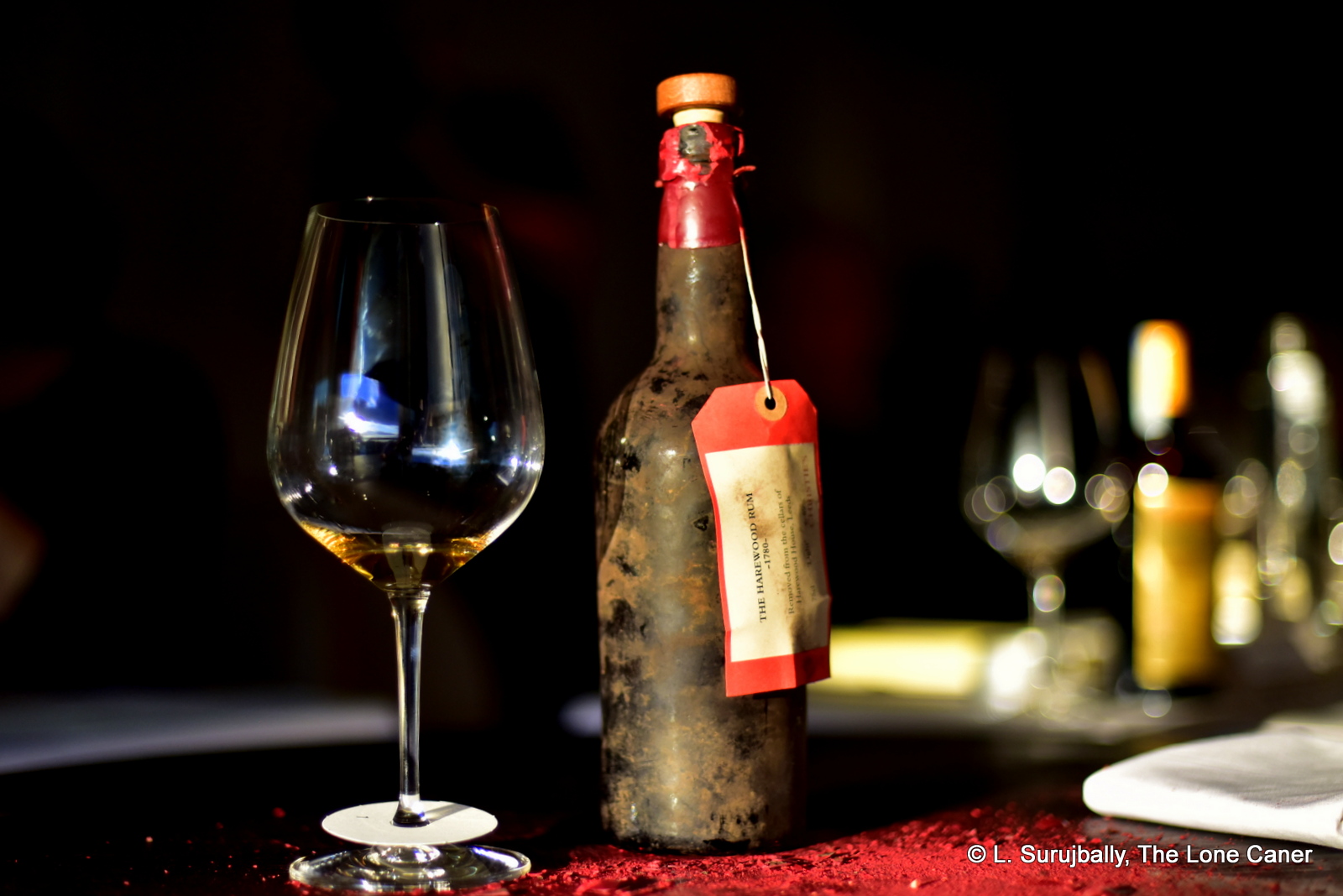
The Harewood Barbados rum from 1780 which was trotted out with a tantara of trumpets and a choir of angels at the Tasting of the Century held in London on September 13th, 2018, will probably stand the test of time as the oldest rum that any reviewer or rum aficionado will ever be able to try – not old in terms of ageing (which in this case is unknown), just with respect to how very long ago it was made. It was exceptional in so many respects that it even eclipsed the launch of the Hampden rums which (together with Ms. Harris’s stunning red ensemble) were ostensibly the real reason for the get-together of so many journalists and rum bloggers.
Given the social media blast which attended that day, many of the facts about the Harewood (bow head, doff cap, genuflect) are now reasonably well known, but since I’ve been following the story since the story broke in 2013, I’ll recap them briefly here. The Harewood estate in Yorkshire was built on the fortune of one Henry Lascelles who arrived in Barbados in 1711, and who within twenty years had built a small empire founded on sugar and banking. In 2011, his descendant Mark Lascelles found 28 cobweb- and filth-encrusted bottles in the cellar of Harewood House and after ascertaining that they were rums, auctioned them off in two lots. The entire (first) collection of twelve handblown bottles sold for £80,000 at Christie’s in 2014, though the buyers were not disclosed by the Daily Mail which reported on the matter. Sleuthing around informs me that Hedonism Wines of London bought one and then resold it for $17,350 to Wealth Solutions who put a capsule into each edition of their collection of 100 Rum Watches within the “Spirits Watches” collection, and the rum has been dubbed the most expensive in the world. Obviously either LMDW or Velier (or both) bought another (or several) and maybe the Whisky Exchange took a third, hence their listing. But who cares? This is beyond history, beyond heritage. This is the rum from further back in time then any of us proles were ever likely to try.
And just look at the Bad Boys of Rum who were called in to help taste it: John Gibbons, Gregers Nielsen, Wes of The Fat Rum Pirate, Steve James of the Rum Diaries Blog, Matt Pietrek the Cocktail Wonk, Pete Holland from the Floating Rum Shack and Tatu Kaarlas of Refined Vices were all there trying this thing at the same time I was — and let me tell you, it was a kinetic experience to hang out with some of the best known writing personages of the rumiverse, and be able to cheerfully talk and sample and poke fun at each other all at the same time.

Photo courtesy of Matt Pietrek The Cocktail Wonk. The Geek Squad soberly considering the Harewood.
In fine, the amazing company aside, it was a fantastic rum. I swear that as we started I regarded the rum with the dark cynicism of an observer of the current American political scene. No way could any rum live up to the hype of the bare stats – 1780; found by accident; oldest from Barbados; most expensive ever; ancient; pure; a window into Ago. “Please God, let this not be an epic fail,” I muttered to myself as I walked over to the tasting to join the Collective. I need not have worried.
The very first — almost disbelieving — notes I wrote down in my book were “How can a rum from that far back smell so modern?” The aroma was like a top end cask strength rum issued today – decant into a new bottle, slap a fancy label and some words on it, and it could be something you see on a shelf in your local spirits emporium boasting a chubby price tag. It started off musty and dusty, something like the Samaroli 1948 West Indian rum. It smelled of glue, sawdust, cedar wood, crushed walnuts, grapes and orange marmalade, all of which came together in an extraordinary balance. It developed into rotting apples, sour cream, gherkins in vinegar, before doing a switcheroo and becoming dry and phenolic. It had briny notes, minty notes, licorice notes, hints of molasses, olives, wood chips, aromatic tobacco, light fruits, clean herbs (almot agricole-like)….and this was all in the first ten minutes. The 69% strength at which it was bottled gave everything, and held back nothing, and I had a sneaking suspicion that if I were to strap it onto my bathtub and add wheels, I could set lap records at the Nurburgring.
And that was just the nose. Tasting it elevated my opinion even more. The strength was totally bearable and not sharp or vinegary or nasty in the slightest – oh sure it was fierce and strong and hot and dry, but it was a full proof rum and this was par for the course – what was remarkable was its overall sippability (is that a real word?). Initial flavours were of light sugar water, apples and watermelon juice (that agricole touch again), acetones, more tobacco, nail polish, grapes, licorice, light molasses, fried bananas and dark chocolate. It also had a texture and taste of unsweetened fresh yoghurt drizzled with olive oil, the musky taste of hummus and pea soup and dark yeasty bread, which gradually retreated into a sort of subtle fruitiness, of orange marmalade, pears and the crispness of unripe yellow mangoes. It was the sort of rum that simply got better as it rested and opened up in the glass, and while I was trying hard not to pay attention to the soft conversation and chirps of delight from my compadres left, right and opposite, I don’t think my appreciation was limited to myself alone. Even the finish was not a let down, and provided a proper ending to the rum – long, aromatic, redolent of light anise and furniture polish, dust, hay and some oak, bitter chocolate, nuts and a last hint of fruitiness too laid back to identify precisely.
In summary…wow! Honestly, if it was commercially available, it should come loaded with a book of quotations that had nothing but expletives, together with a thesaurus listing all the equivalents to the word “awesome”, just in case one’s vocabulary isn’t up to the task. Would I recognize it blind? Is it representative of Barbados at all? I don’t know – probably not. What I think is that it’s a rum trembling right on the edge of being off the scale.

The Harewood 1780 is, to me, one of the most paradoxical rums I’ve ever tried, because with a very few exceptions, almost nobody who could afford it could possibly appreciate it, and just about nobody who can appreciate it could possibly afford it (one exception, as all are aware, is Luca Gargano, who organized this epic event and about whom no more need be said). Moreover, aside from being the oldest rum in existence (for now) the rum is amazing in one other respect — it adheres to a profile so modern that were one to taste it without knowing what it was (fat chance, I know), it would not be out of the realms of possibility to give it a great score and then ask wonderingly which new independent on the rum scene made this damned thing.
But we couldn’t try it blind – and much as I tried to not let the heritage and age of this rum sway my mind and my scoring, the fact of the matter was that the panoply of tastes and the complexity of the whole experience could not be denied. We who sat down that day and tried this rum were privileged beyond all measure to have a window opened up into the way rums tasted back then, how they were different from now…yet also curiously the same. For all the changes that have occurred in the industry and the technology between 1780 and 2018, the truth is that the current inheritors of the tradition of quality rum-making aren’t that far away from what was once being made. And that is all to the credit of both those who came before, and those who make rums now.
(#549)(unscored)
Other notes
- Although initially I scored this rum – and very high – subsequent thought made me realize the pointlessness of such a thing for a rum that is so limited, so old and so exclusive. It will never be made again, not this way, if ever. A score is therefore meaningless, and I have removed it.
- Although not clearly or widely articulated at the time, there were some moral issues with selling a rum made by the labour of slaves – a way around the matter was found by donating all the proceeds of the sales to charity. Note that in June 2019, one attendee, a spirits writer named Jason Wilson, took on this uncomfortable subject head on in an article for Medium online magazine (that link subsequently disappeared and is dead, and Wilson reposted it on his own website “Everday Drinking” in 2023). All this did not, however, stop a British white-hatted black rum promoter who opines volubly about racism and opportunities not given to people of colour, from buying one for himself without a word or comment of protest at its origins. I guess the irony escaped him.
- Since the modern columnar still had not been invented at the time, it stands to reason the rum was made on a pot still of some kind.
- The rum was distilled in two forms, according to Christie’s – “Light” and “Dark”, with apparently differing taste profiles. Whether the terms were used for colours or an actual distillation technique is unknown, but it’s with some dismay that I now have to see if in my lifetime I can find a sample of the “Dark”. The Light tested at 69.38% ABV and the Dark at 57.76% (page 40 of Christie’s catalogue)
- Links to other articles on the Rum Tasting of the Century (to be updated as other articles appear):
- Rum Diaries Blog event narrative.
- Cocktail Wonk write up of the evening
- Marco Zucchetti for WhiskyFacile reviews the rums: Part 1 and Part 2 (Italian only)
- Velier home page press roundup
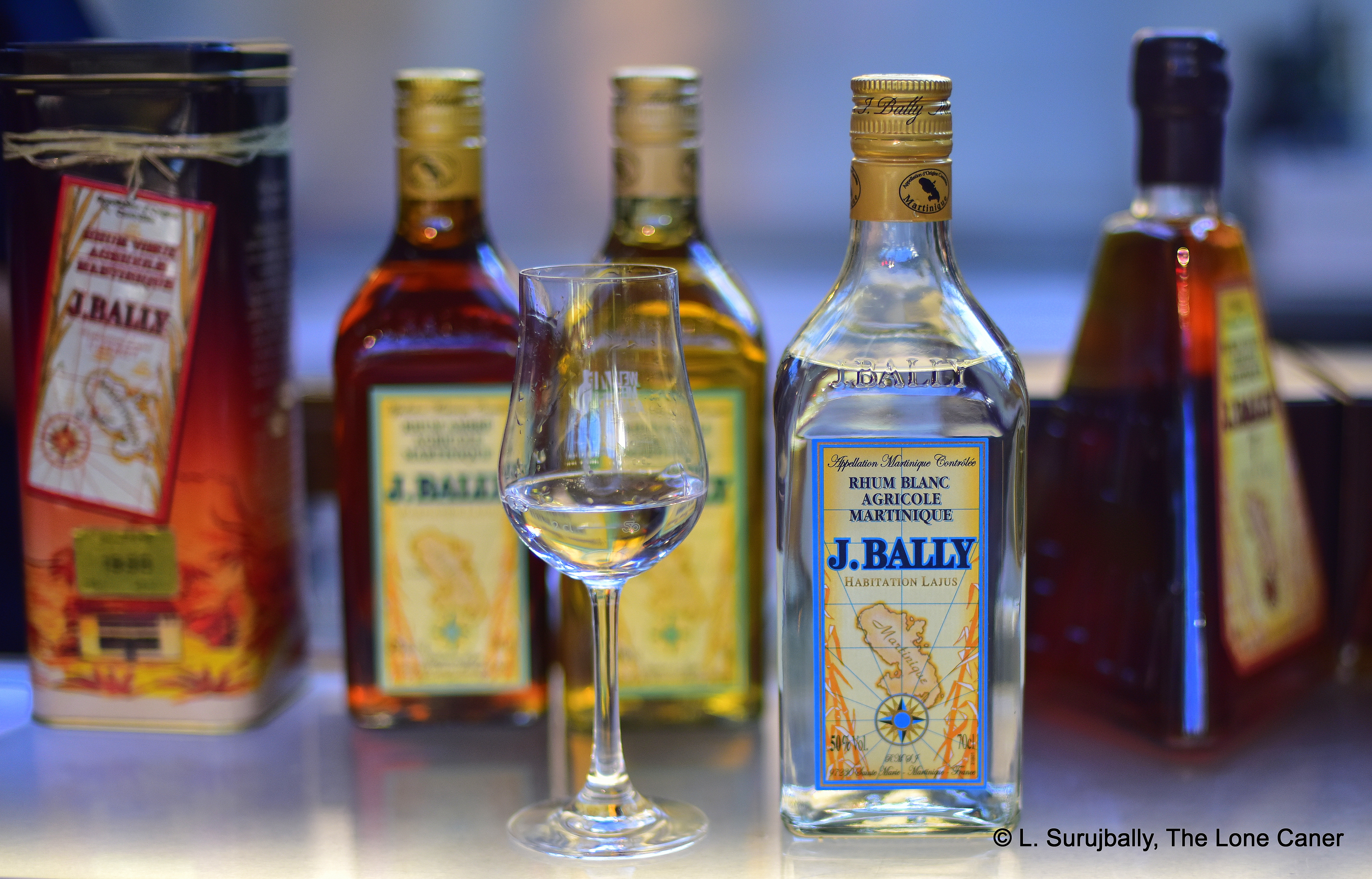
 Well, that out of the way, let me walk you through the profile. Nose first: what was immediately evident is that it adhered to all the markers of a crisp agricole. It gave off of light grassy notes, apples gone off the slightest bit, watermelon, very light citrus and flowers. Then it sat back for some minutes, before surging forward with more: olives in brine, watermelon juice, sugar cane sap, peaches, tobacco and a sly hint of herbs like dill and cardamom.
Well, that out of the way, let me walk you through the profile. Nose first: what was immediately evident is that it adhered to all the markers of a crisp agricole. It gave off of light grassy notes, apples gone off the slightest bit, watermelon, very light citrus and flowers. Then it sat back for some minutes, before surging forward with more: olives in brine, watermelon juice, sugar cane sap, peaches, tobacco and a sly hint of herbs like dill and cardamom.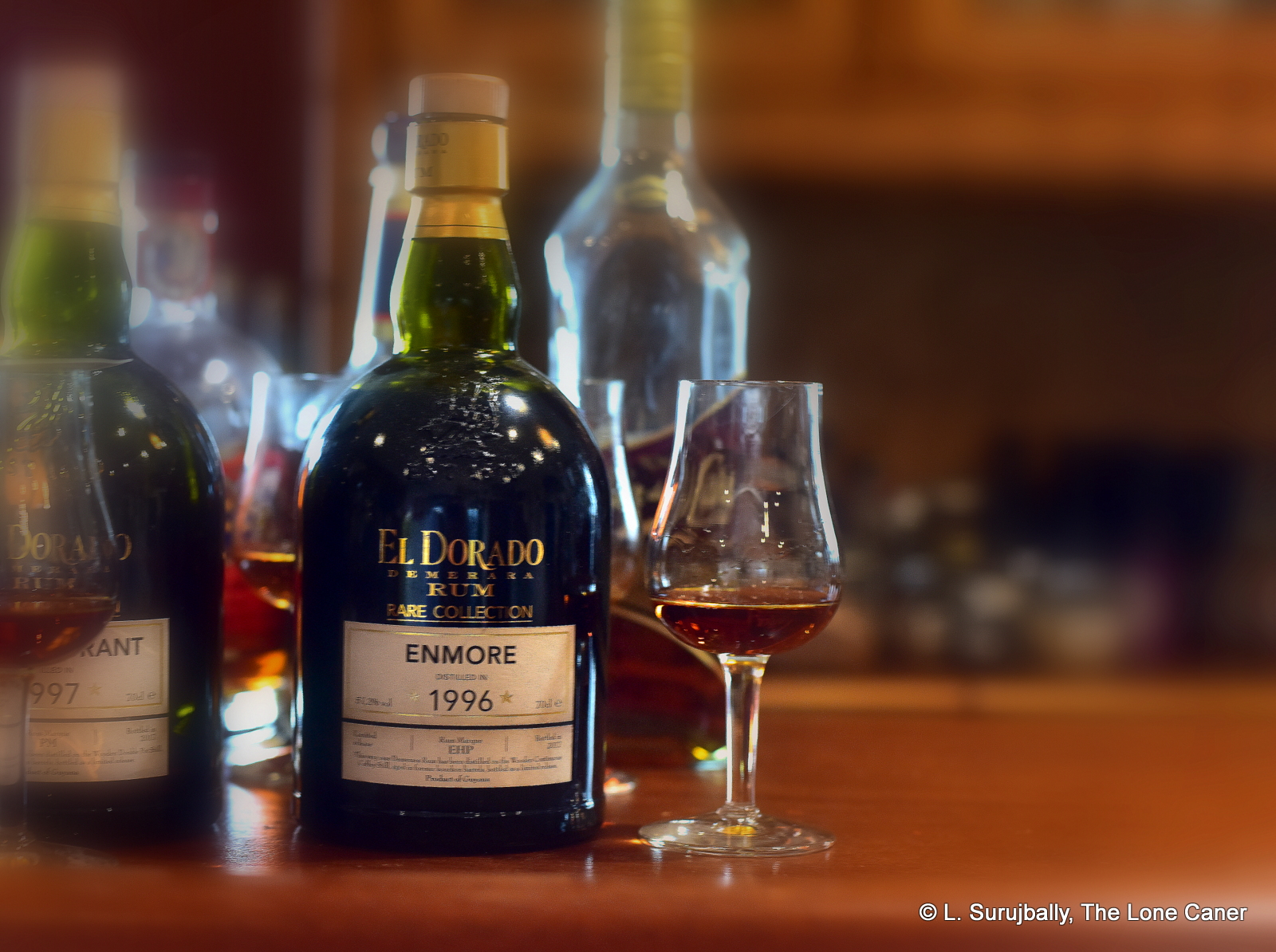

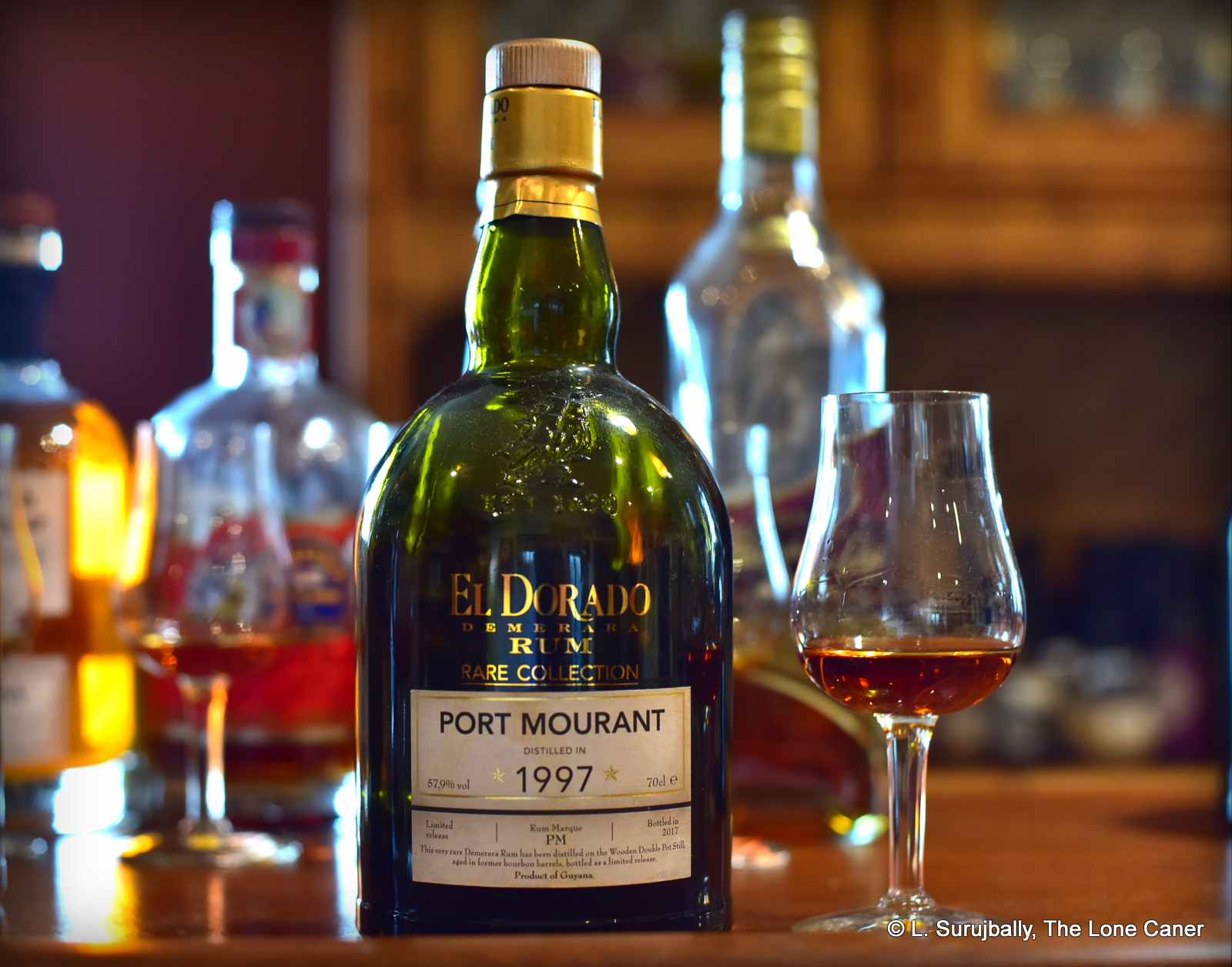
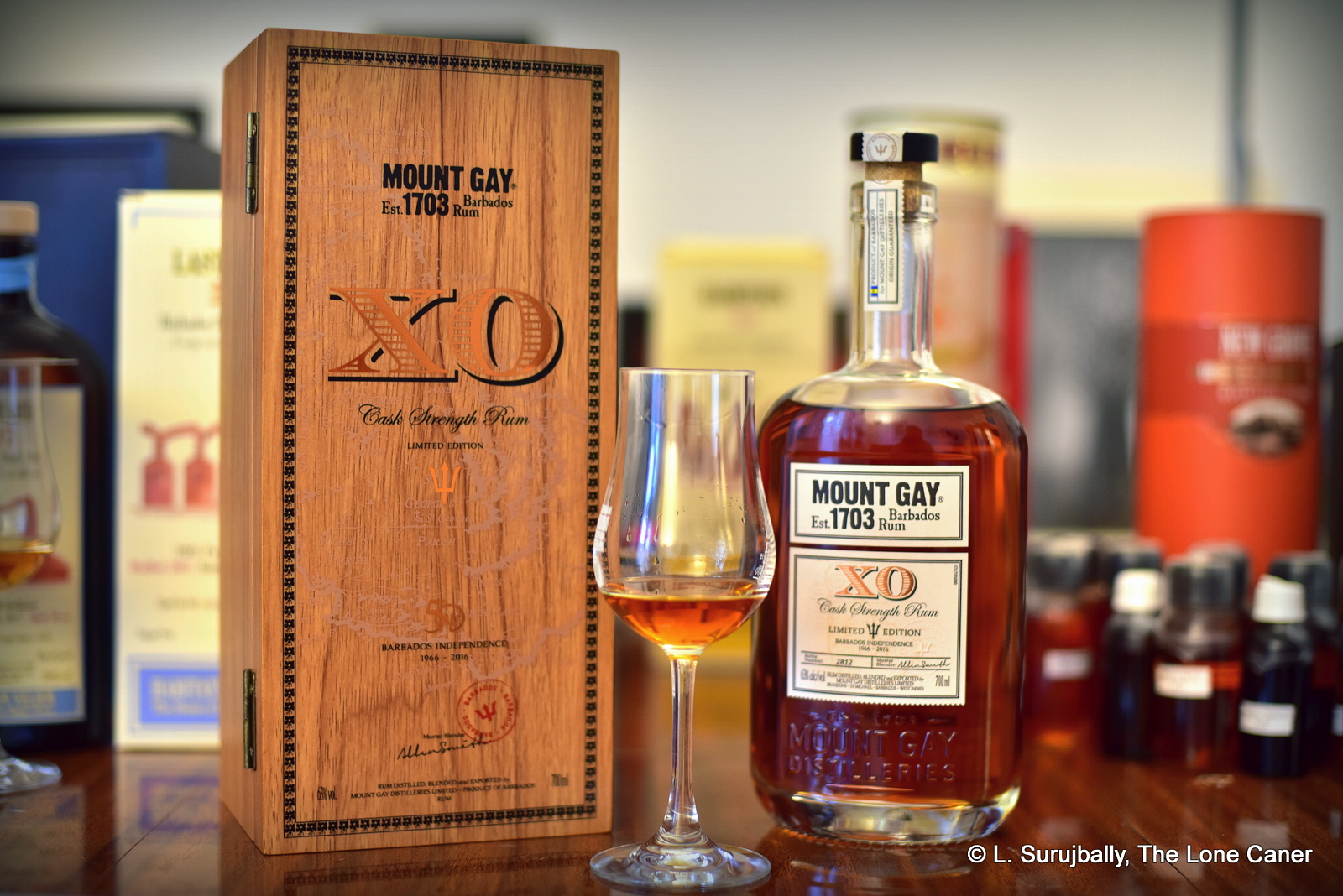
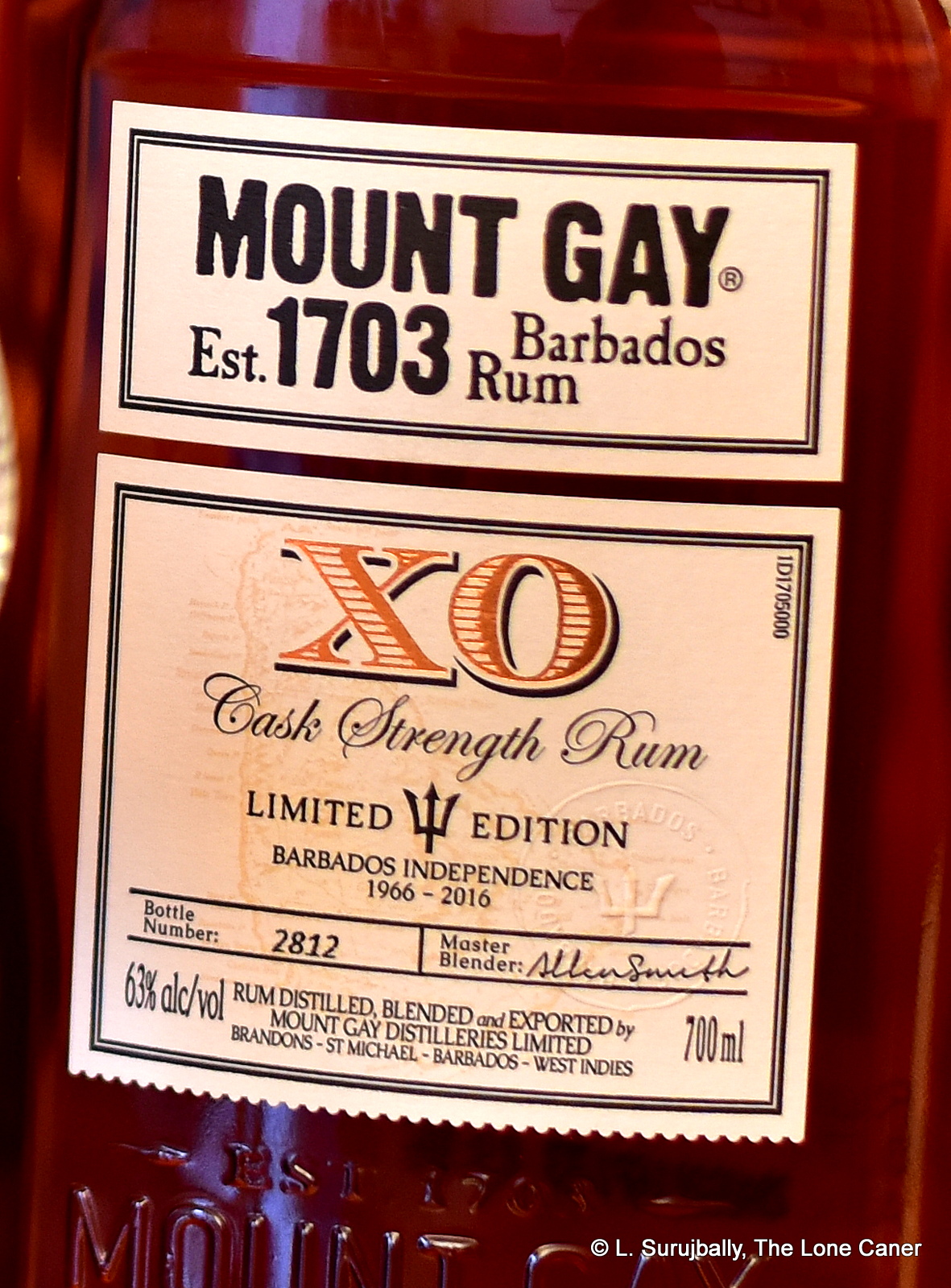 You can’t fault the presentation or the stats (though you might balk at the price). The ovoid bottle is nicely labelled with the bottle number and Allen Smith’s signature, comes in a handsome wooden box with a small booklet in it that speaks to the rum. It doesn’t state the outturn on the label, but it’s 3000 bottles, a rum to mark fifty years of independence though itself it is not that old, being a blend of pot and column still rums aged between 8-15 years old (just like the regular XO, even if one gets the impression that certain select barrels were chosen here). And of course the main selling point, the 63% ABV, Mount Gay’s first serious foray into these strong and dangerous rum currents.
You can’t fault the presentation or the stats (though you might balk at the price). The ovoid bottle is nicely labelled with the bottle number and Allen Smith’s signature, comes in a handsome wooden box with a small booklet in it that speaks to the rum. It doesn’t state the outturn on the label, but it’s 3000 bottles, a rum to mark fifty years of independence though itself it is not that old, being a blend of pot and column still rums aged between 8-15 years old (just like the regular XO, even if one gets the impression that certain select barrels were chosen here). And of course the main selling point, the 63% ABV, Mount Gay’s first serious foray into these strong and dangerous rum currents.
 Rumaniacs Review #083 | 0544
Rumaniacs Review #083 | 0544 Opinion
Opinion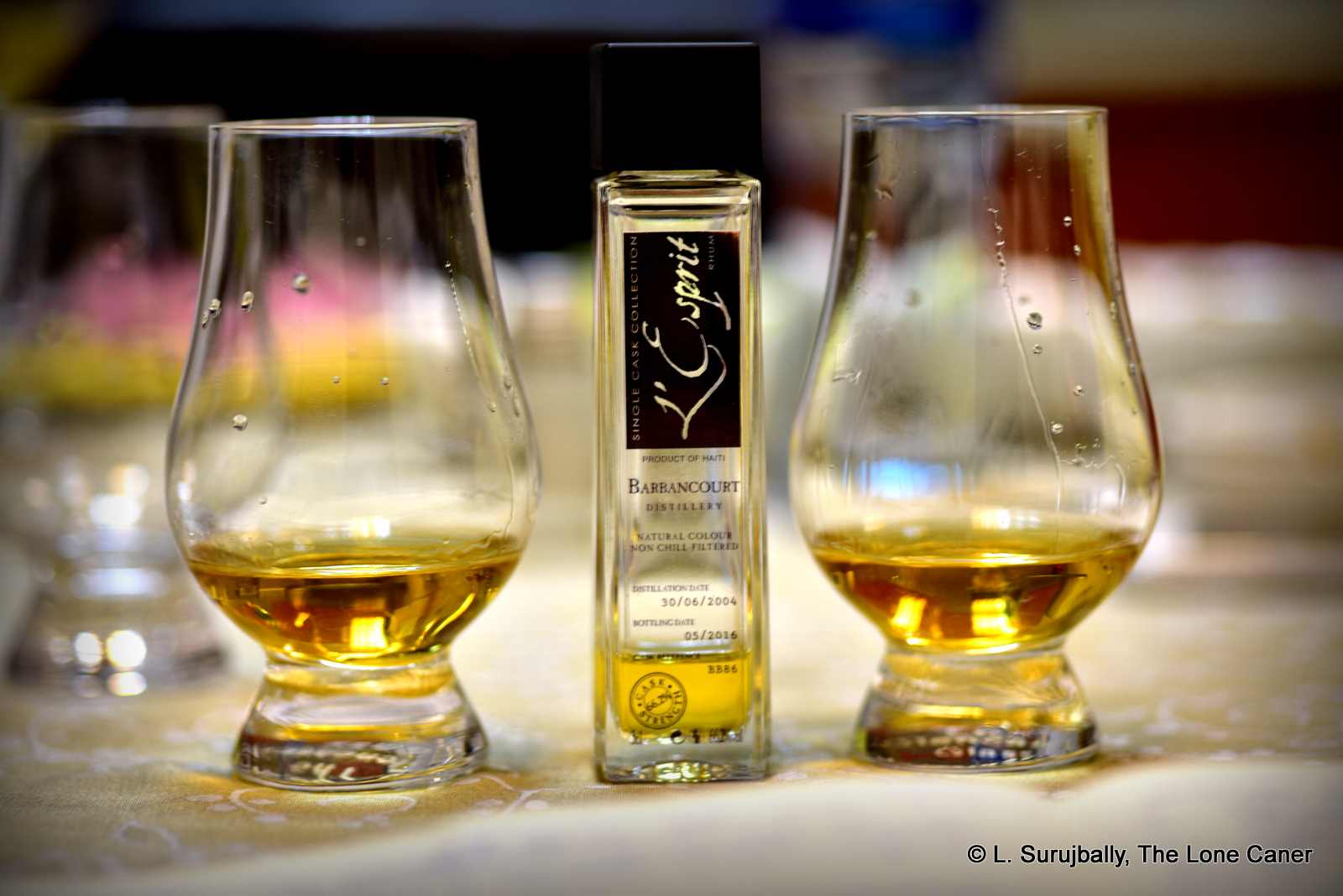
 The bare statistics are brief and as follows: column still product, continentally aged; distilled 2004 and released in 2016 at a brobdingnagian 66.2% (its lesser proofed twin which is quite similar is bottled at 46% and 228 bottles were issued but about the full proof edition here, I’m not certain – less, for sure, maybe a hundred or so). Pale yellow in colour and a massive codpiece of a nose, deep and intense, which should not present as a surprise at all. It was quite aromatic as well – one could sense bananas, vanilla, prunes and fruit, with a nice counterpoint of citrus to set these off. Like many rums released at cask strength, it rewarded patience because after a while back-end smells of cream cheese, dark bread, brine, olives, nail polish, plastic bubble wrap (freshly popped), paint became much more evident, though fortunately without taking over entirely
The bare statistics are brief and as follows: column still product, continentally aged; distilled 2004 and released in 2016 at a brobdingnagian 66.2% (its lesser proofed twin which is quite similar is bottled at 46% and 228 bottles were issued but about the full proof edition here, I’m not certain – less, for sure, maybe a hundred or so). Pale yellow in colour and a massive codpiece of a nose, deep and intense, which should not present as a surprise at all. It was quite aromatic as well – one could sense bananas, vanilla, prunes and fruit, with a nice counterpoint of citrus to set these off. Like many rums released at cask strength, it rewarded patience because after a while back-end smells of cream cheese, dark bread, brine, olives, nail polish, plastic bubble wrap (freshly popped), paint became much more evident, though fortunately without taking over entirely
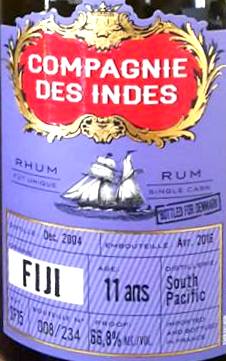 It was obvious after one tiny sniff, that not one percentage point of all that proofage was wasted and it was all hanging out there: approaching with caution was therefore recommended. I felt like I was inhaling a genetically enhanced rum worked over by a team of uber-geek scientists working in a buried government lab somewhere, who had evidently seen King Kong one too many times. I mean, okay, it wasn’t on par with the
It was obvious after one tiny sniff, that not one percentage point of all that proofage was wasted and it was all hanging out there: approaching with caution was therefore recommended. I felt like I was inhaling a genetically enhanced rum worked over by a team of uber-geek scientists working in a buried government lab somewhere, who had evidently seen King Kong one too many times. I mean, okay, it wasn’t on par with the 

 That said, the still which produced this pale yellow 57.19% ABV rum remains an open question, though my personal belief is that it’s a column still product. It certainly noses that way – aside from presenting as a fierce little young rum, it lacks something of the depth and pungency of a pot still spirit. However, that doesn’t matter, because it’s damn fine on its own merits – brine, olives, paint, turpentine, acetones, fresh nail polish, more brine and gherkins, and that’s just the beginning. It has aspects that are almost Jamaican, what with a bunch of prancing dancing esters jostling for attention, except that the smell is not so crisply sweet. It develops very nicely into smoke, leather, linseed oil for cricket bats, more brine and oily smoothness. Like a set of seething rapids finished with the messing around, it settles down to a much more refined state after half an hour or so.
That said, the still which produced this pale yellow 57.19% ABV rum remains an open question, though my personal belief is that it’s a column still product. It certainly noses that way – aside from presenting as a fierce little young rum, it lacks something of the depth and pungency of a pot still spirit. However, that doesn’t matter, because it’s damn fine on its own merits – brine, olives, paint, turpentine, acetones, fresh nail polish, more brine and gherkins, and that’s just the beginning. It has aspects that are almost Jamaican, what with a bunch of prancing dancing esters jostling for attention, except that the smell is not so crisply sweet. It develops very nicely into smoke, leather, linseed oil for cricket bats, more brine and oily smoothness. Like a set of seething rapids finished with the messing around, it settles down to a much more refined state after half an hour or so.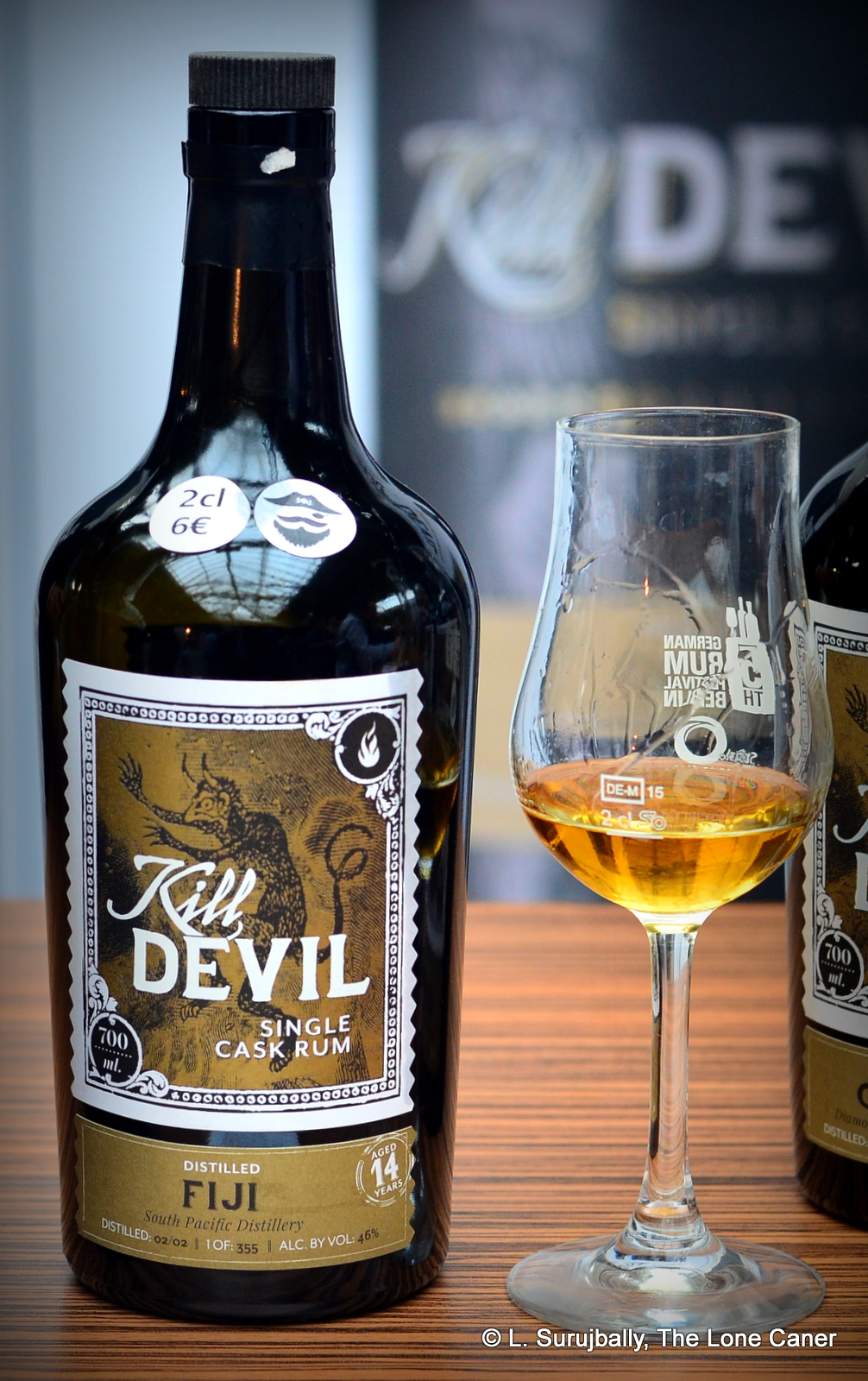 Kill Devil is the rum brand of the whiskey blender Hunter Laing, who’ve been around since 1949 when Frederick Laing founded a whisky blending company in Glasgow. In 2013 the company created an umbrella organization called Hunter Laing & Co, into which they folded all their various companies (like Edition Spirits and the Premier Bonding bottling company). The first rums they released to the market – with all the now-standard provisos like being unadulterated, unfiltered and 46% – arrived for consumers in 2016, which meant that this rum from the South Pacific Distillery on Fiji, was issued as part of their first batch (oddly, their own website provides no listing of their rums at all aside from boilerplate blurbs). When the time came for me to decide what to sample, the
Kill Devil is the rum brand of the whiskey blender Hunter Laing, who’ve been around since 1949 when Frederick Laing founded a whisky blending company in Glasgow. In 2013 the company created an umbrella organization called Hunter Laing & Co, into which they folded all their various companies (like Edition Spirits and the Premier Bonding bottling company). The first rums they released to the market – with all the now-standard provisos like being unadulterated, unfiltered and 46% – arrived for consumers in 2016, which meant that this rum from the South Pacific Distillery on Fiji, was issued as part of their first batch (oddly, their own website provides no listing of their rums at all aside from boilerplate blurbs). When the time came for me to decide what to sample, the 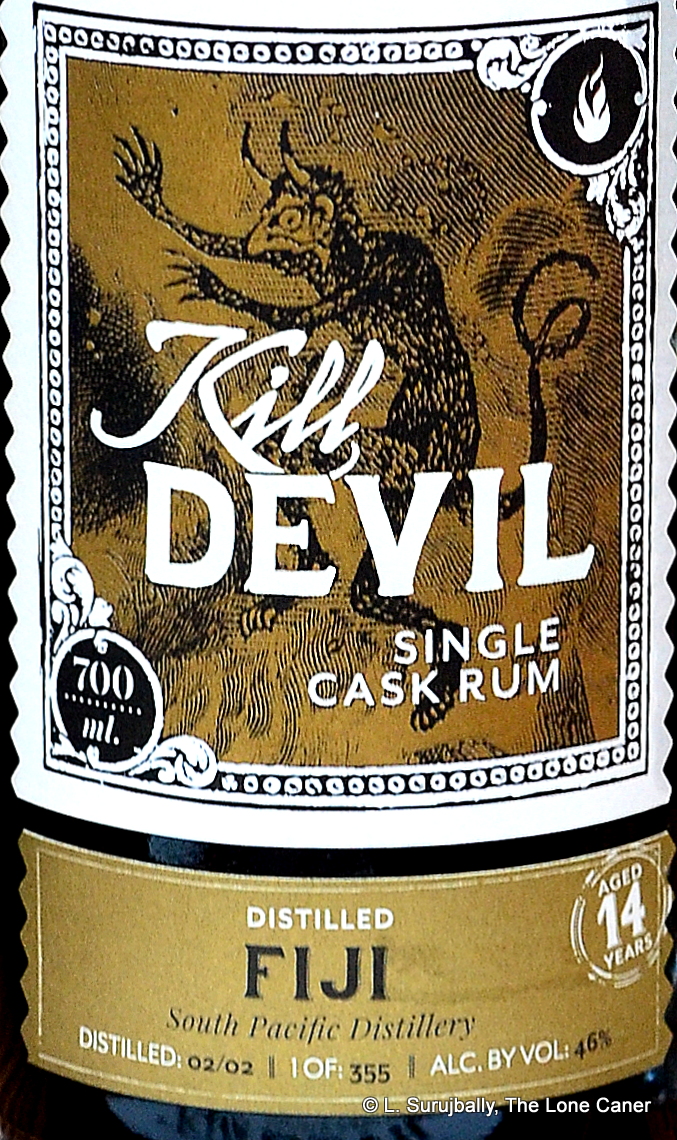 On the palate the fruits started to take over, tart and a unripe, like ginnips and soursop together with ripe mangoes, pineapple and cherries in syrup right out of a can – there was hardly any of the brininess from the nose carrying over, and as it developed, additional hints of pears, watermelon, honey, and pickled gherkins were clearly noticeable. It was warm and crisp at the same time, quite nice, and while the long and heated finish added nothing new to the whole experience, it didn’t lose any of the flavours either; and I was left thinking that while different from other Fijians for sure, it seemed to be channelling a sly note of Jamaican funk throughout, and that was far from unpleasant….though perhaps a bit at odds with the whole profile.
On the palate the fruits started to take over, tart and a unripe, like ginnips and soursop together with ripe mangoes, pineapple and cherries in syrup right out of a can – there was hardly any of the brininess from the nose carrying over, and as it developed, additional hints of pears, watermelon, honey, and pickled gherkins were clearly noticeable. It was warm and crisp at the same time, quite nice, and while the long and heated finish added nothing new to the whole experience, it didn’t lose any of the flavours either; and I was left thinking that while different from other Fijians for sure, it seemed to be channelling a sly note of Jamaican funk throughout, and that was far from unpleasant….though perhaps a bit at odds with the whole profile.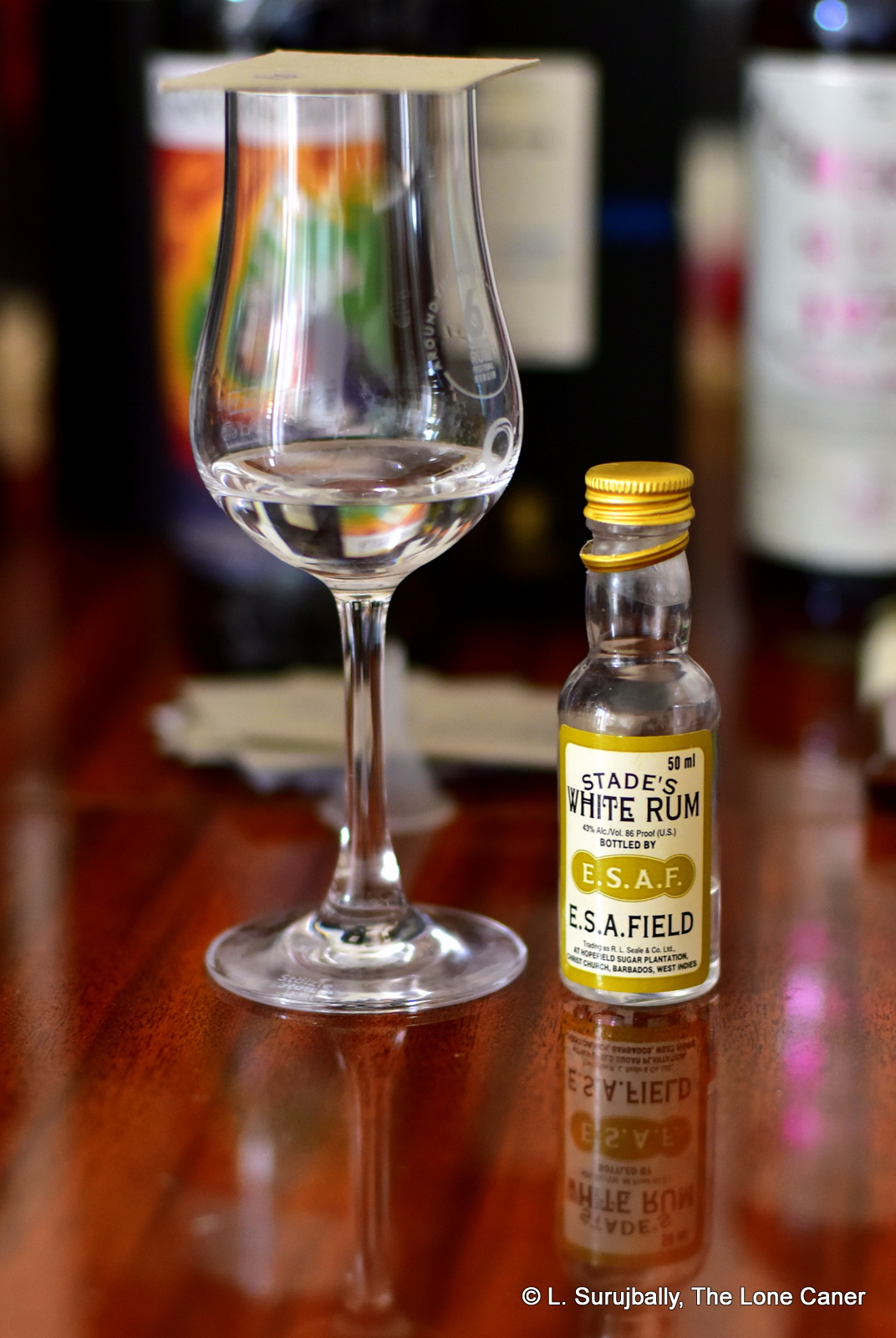

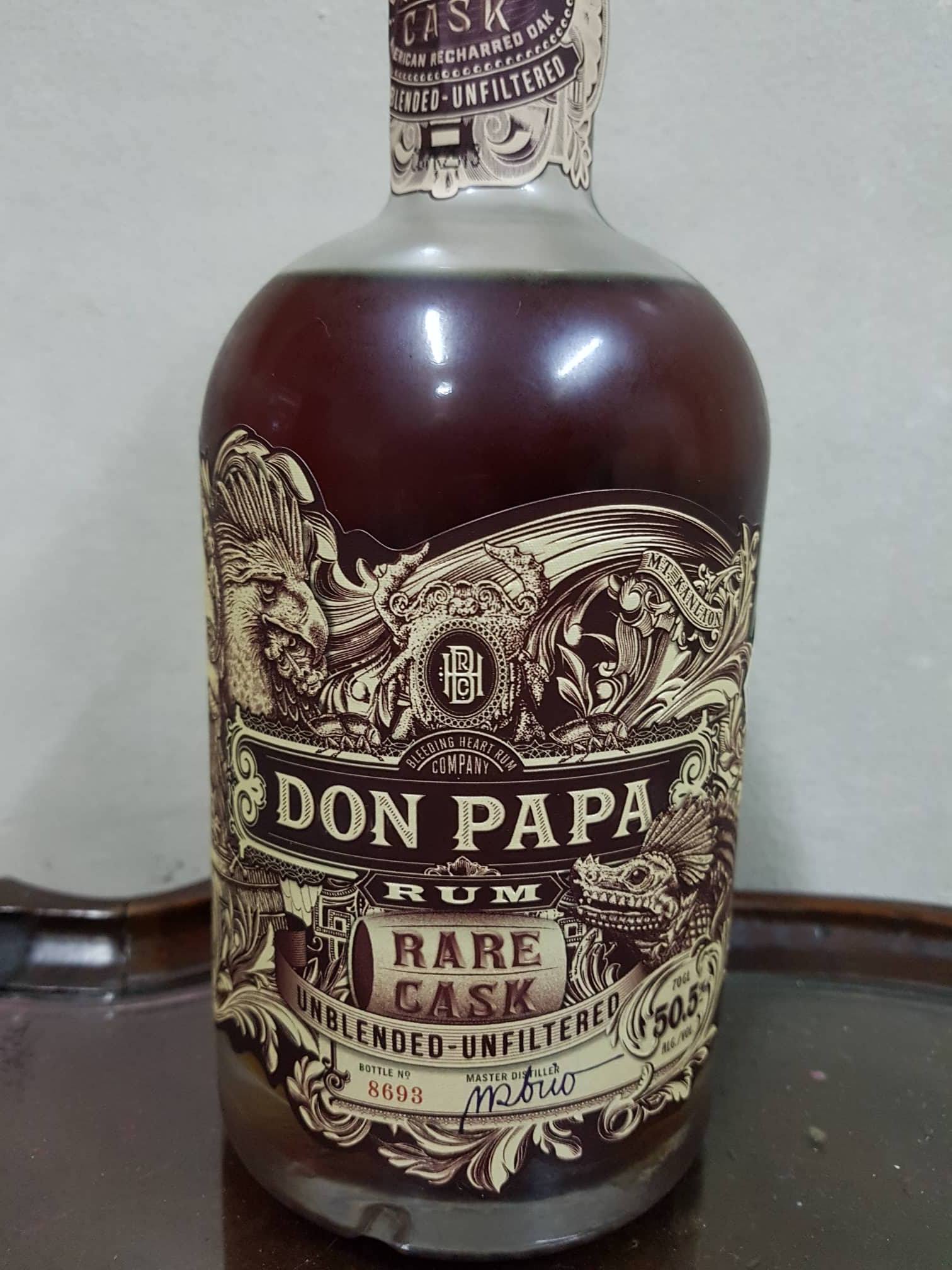
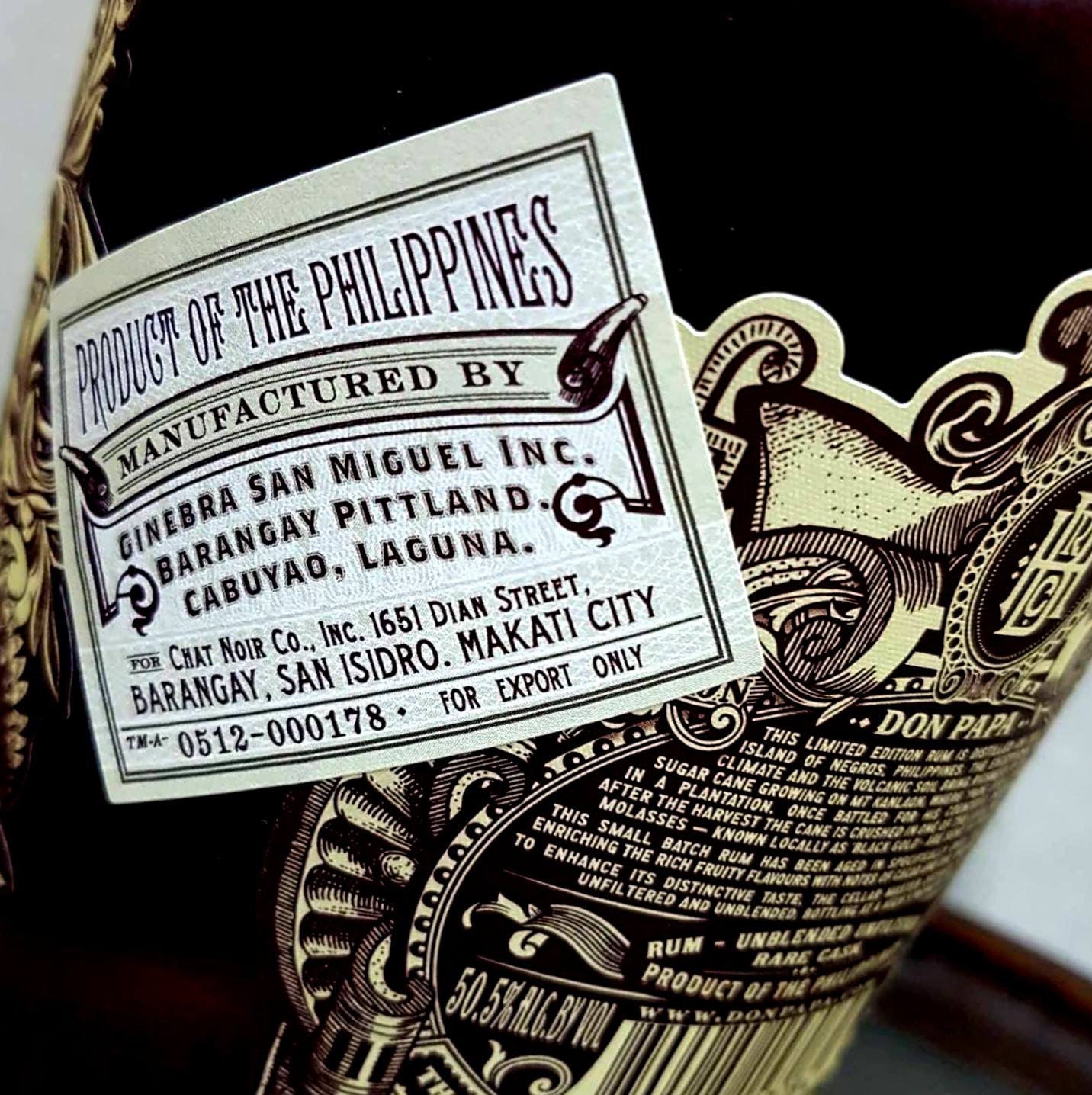

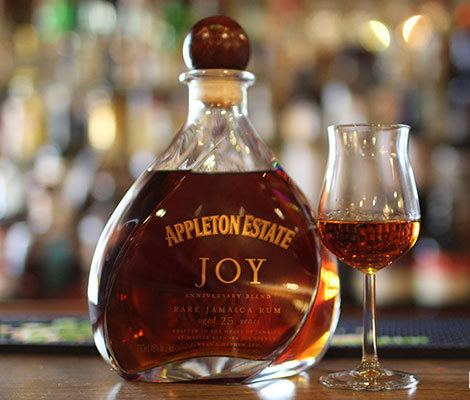
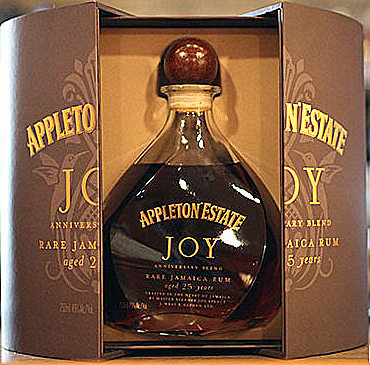

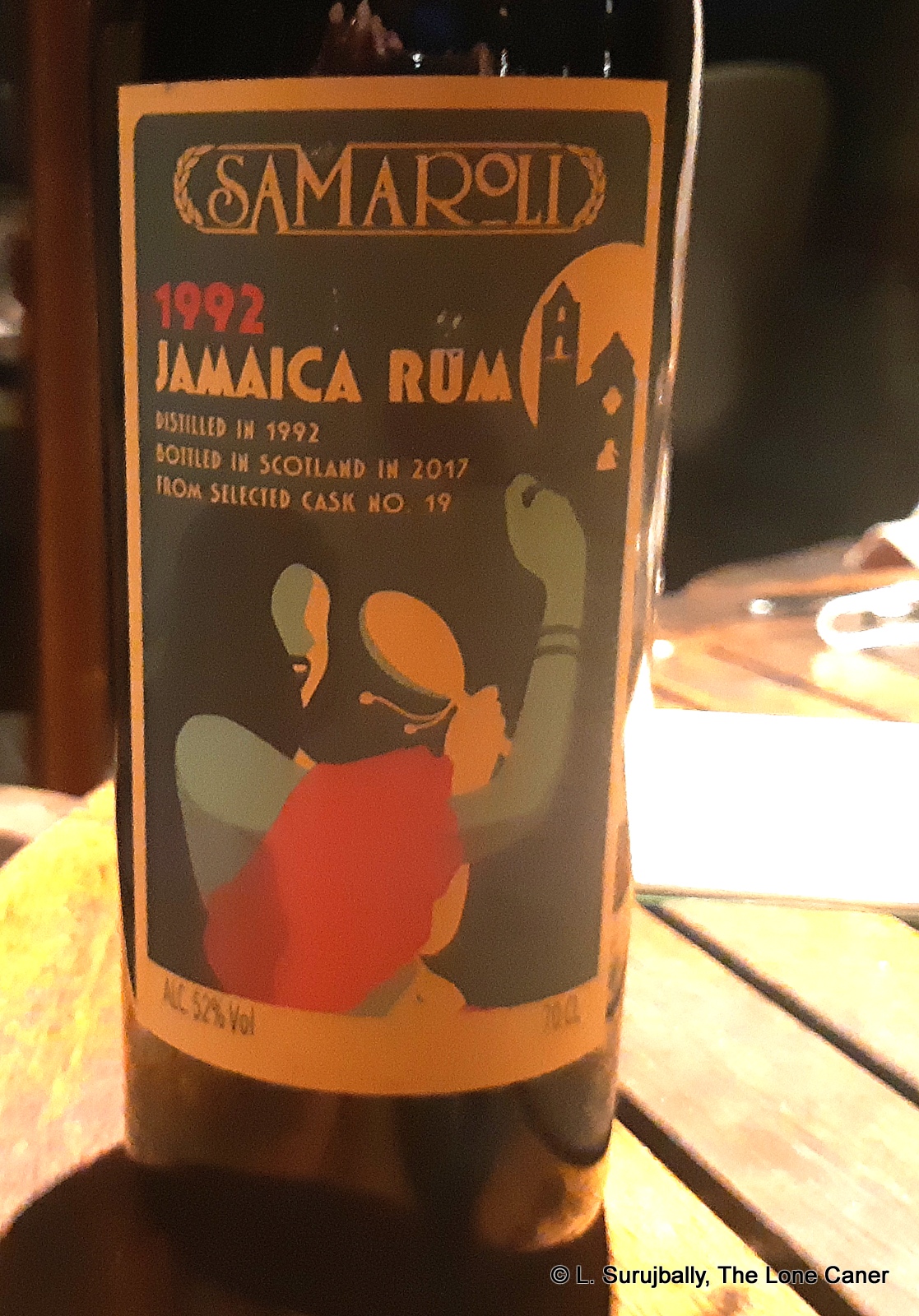 And the taste, the palate, the way it comes together, it’s masterful. At 52% it’s downright near damned perfect – the the balance between mouth puckering citrus plus laid back funk, and easier, softer flavours is unbelievably well done. Soda pop, honey, cereal, red currants, raspberries, fanta and orange zest dance exuberantly cross the tongue, never faltering, never allowing any one piece to dominate. Like an exquisitely choreographed dance number, the molasses, vanillas and fruits (peaches, yellow plums, pears, ripe yellow Thai mangoes) tango alongside sharper notes of citrus, lemon zest, overripe bananas, sandalwood and ginger. Even the finish is spectacular – just long enough, just sharp enough, just mellow enough, allowing each of the individually discerned flavours of fruits, toffee, chocolate and citrus to come out on stage one last time for a bow, before fading back and making way for the next one
And the taste, the palate, the way it comes together, it’s masterful. At 52% it’s downright near damned perfect – the the balance between mouth puckering citrus plus laid back funk, and easier, softer flavours is unbelievably well done. Soda pop, honey, cereal, red currants, raspberries, fanta and orange zest dance exuberantly cross the tongue, never faltering, never allowing any one piece to dominate. Like an exquisitely choreographed dance number, the molasses, vanillas and fruits (peaches, yellow plums, pears, ripe yellow Thai mangoes) tango alongside sharper notes of citrus, lemon zest, overripe bananas, sandalwood and ginger. Even the finish is spectacular – just long enough, just sharp enough, just mellow enough, allowing each of the individually discerned flavours of fruits, toffee, chocolate and citrus to come out on stage one last time for a bow, before fading back and making way for the next one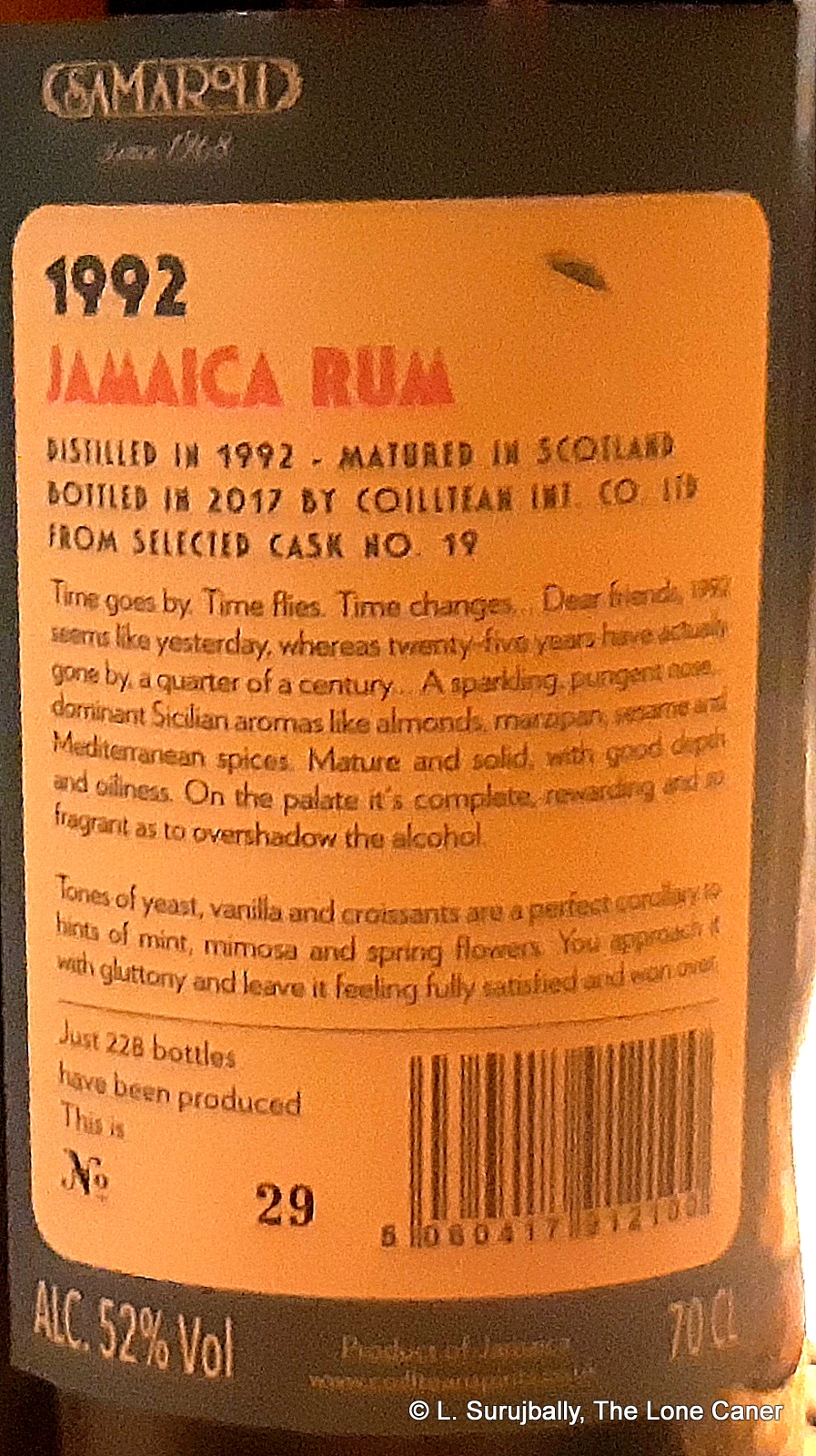 I don’t know what they did differently in this rum from others they’ve issued for the last forty years, what selection criteria they used, but
I don’t know what they did differently in this rum from others they’ve issued for the last forty years, what selection criteria they used, but 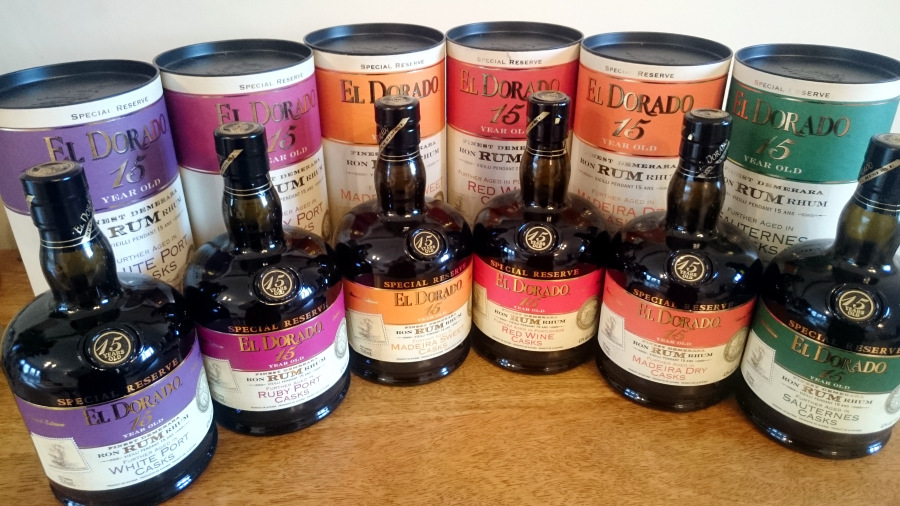

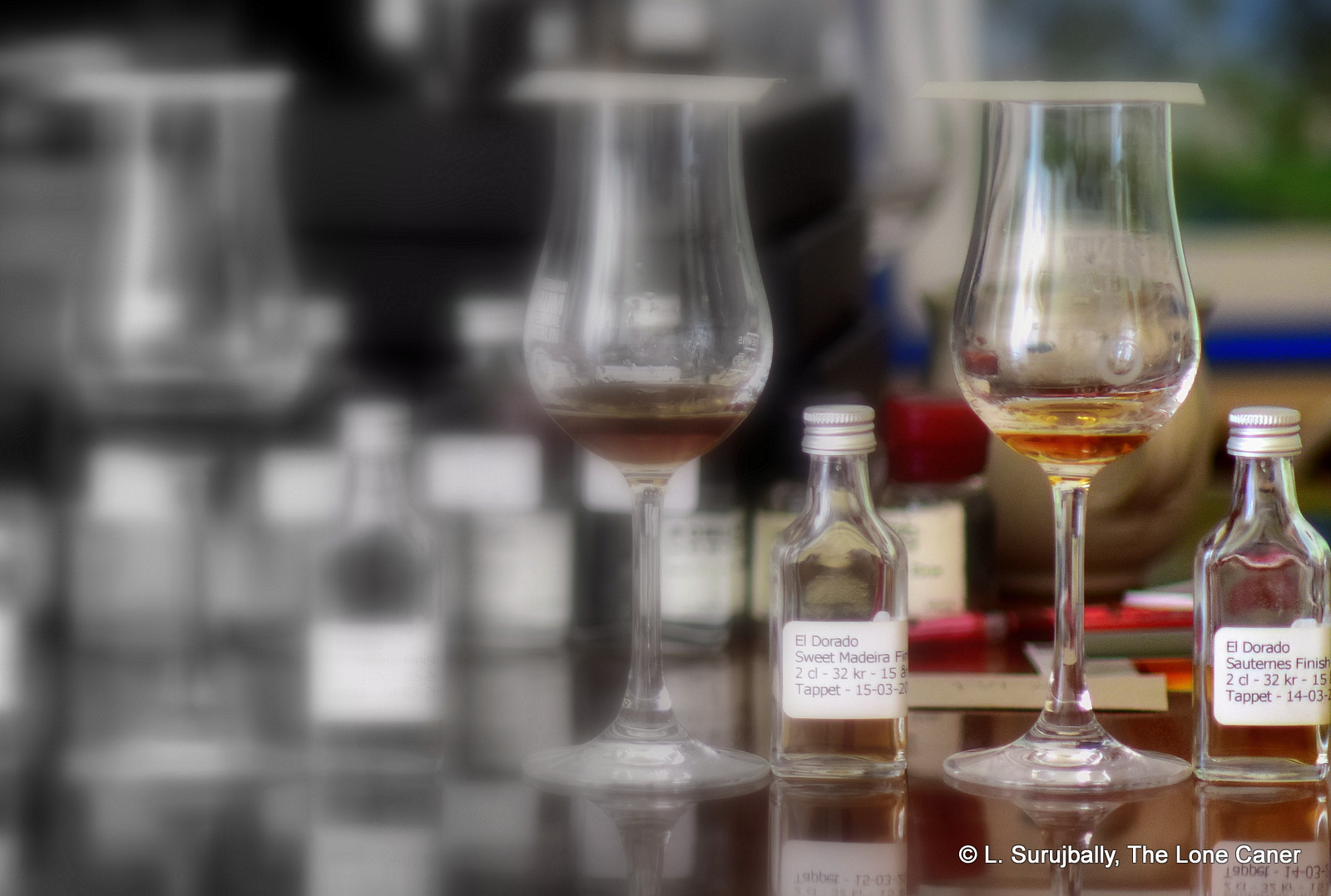
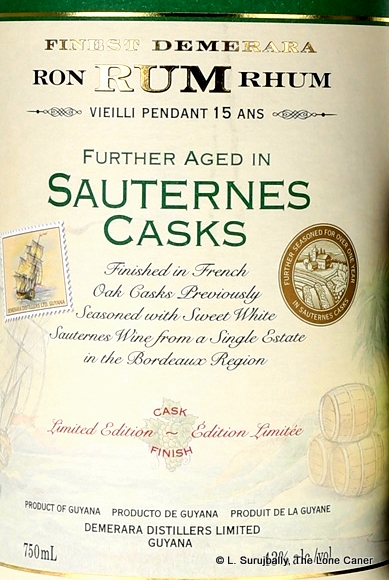 Nose – In a subtle way this is different from the others. It opens with aromatic tobacco, white almond-stuffed chocolate and nail polish before remembering what it’s supposed to be and retreating to the standard profile of salty caramel, molasses, vanilla, cherries, raisins, lemon peel and oak, quite a bit of oak, all rather sere.
Nose – In a subtle way this is different from the others. It opens with aromatic tobacco, white almond-stuffed chocolate and nail polish before remembering what it’s supposed to be and retreating to the standard profile of salty caramel, molasses, vanilla, cherries, raisins, lemon peel and oak, quite a bit of oak, all rather sere.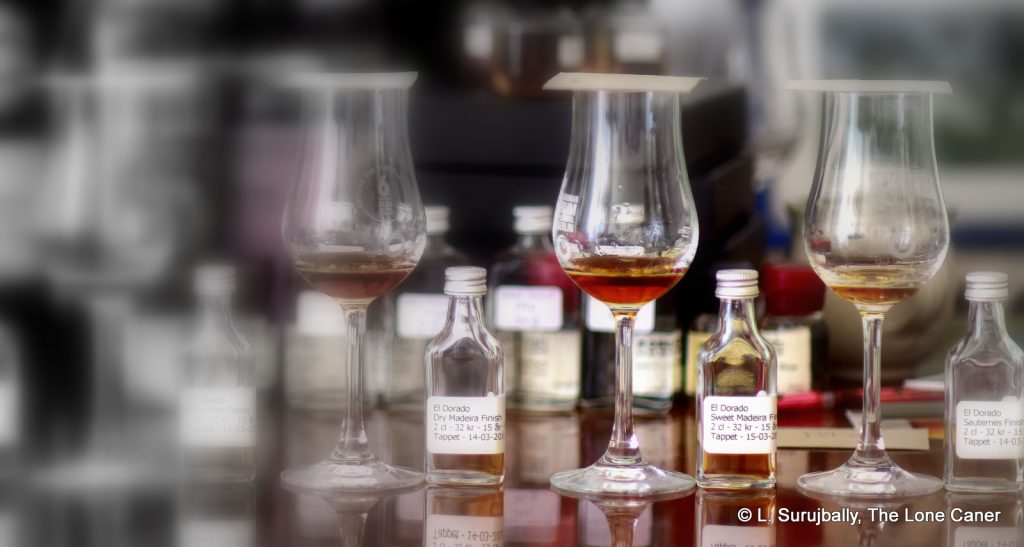
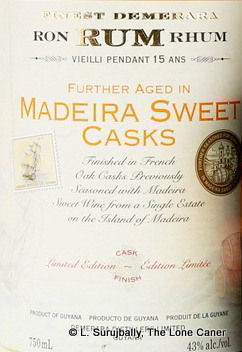 Nose – Leaving aside a slight sweetish note (which I suppose is to be expected, though still not entirely welcome), it noses relatively darker and richer and fruitier than just about all the others except the “Dry”…within the limits of its strength and mild adulteration. Peaches, raisins, cinnamon, cloves, caramel, peanut butter, cherries in syrup and candied oranges, even a little bitter chocolate. It’s all rather delicate, but quite pleasant.
Nose – Leaving aside a slight sweetish note (which I suppose is to be expected, though still not entirely welcome), it noses relatively darker and richer and fruitier than just about all the others except the “Dry”…within the limits of its strength and mild adulteration. Peaches, raisins, cinnamon, cloves, caramel, peanut butter, cherries in syrup and candied oranges, even a little bitter chocolate. It’s all rather delicate, but quite pleasant.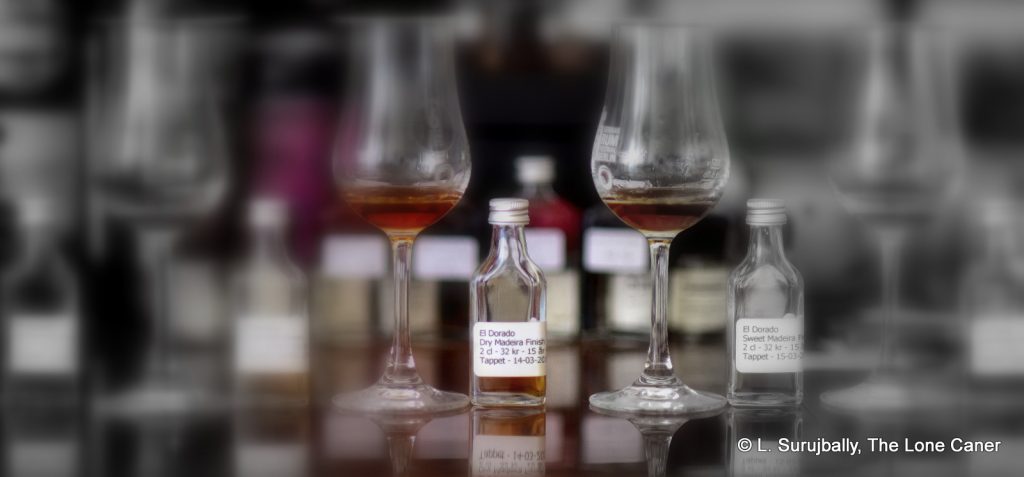
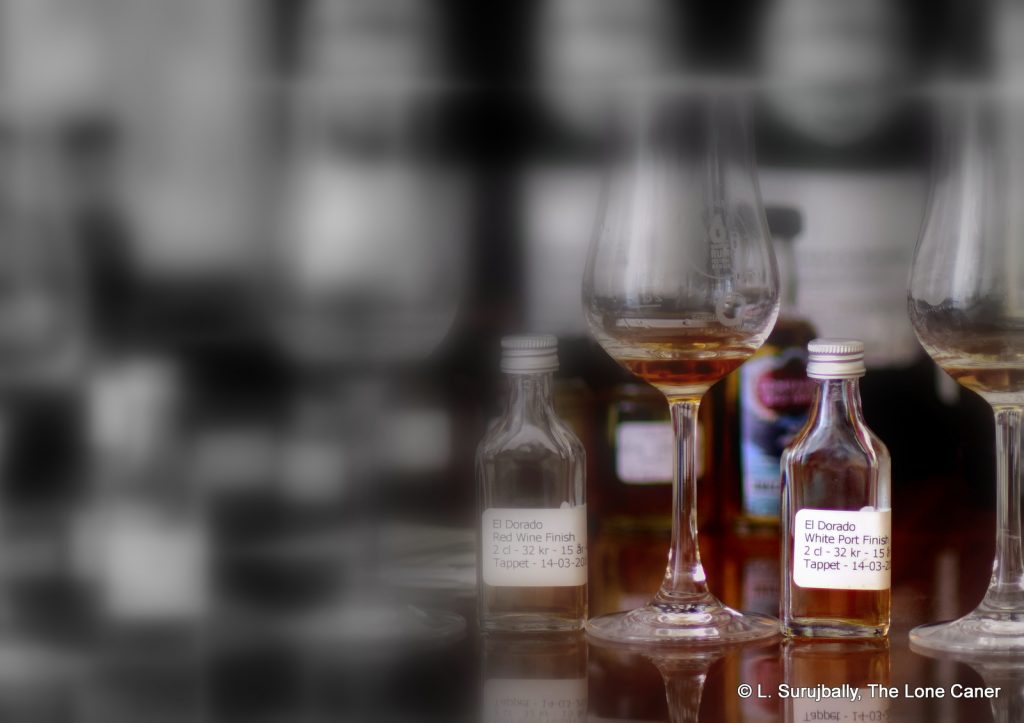
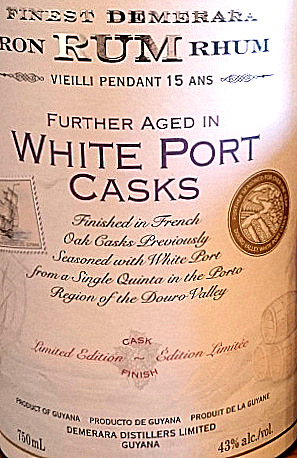 Nose – At first there didn’t seem to be much of anything there, it was so mild as to be lightly flavoured alcohol. But after some minutes it got into gear and revved up some, with a solid core of light brown sugar, molasses, salt caramel, some sweet soya. Not much deep fruitiness here, just light grapefruit, bananas and nuttiness, and sweet white chocolate.
Nose – At first there didn’t seem to be much of anything there, it was so mild as to be lightly flavoured alcohol. But after some minutes it got into gear and revved up some, with a solid core of light brown sugar, molasses, salt caramel, some sweet soya. Not much deep fruitiness here, just light grapefruit, bananas and nuttiness, and sweet white chocolate.